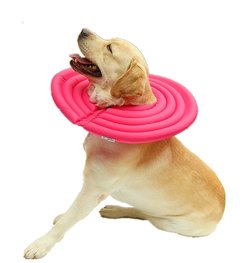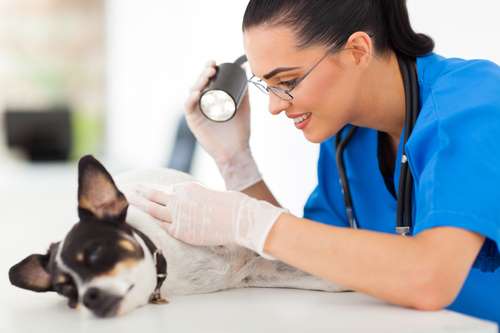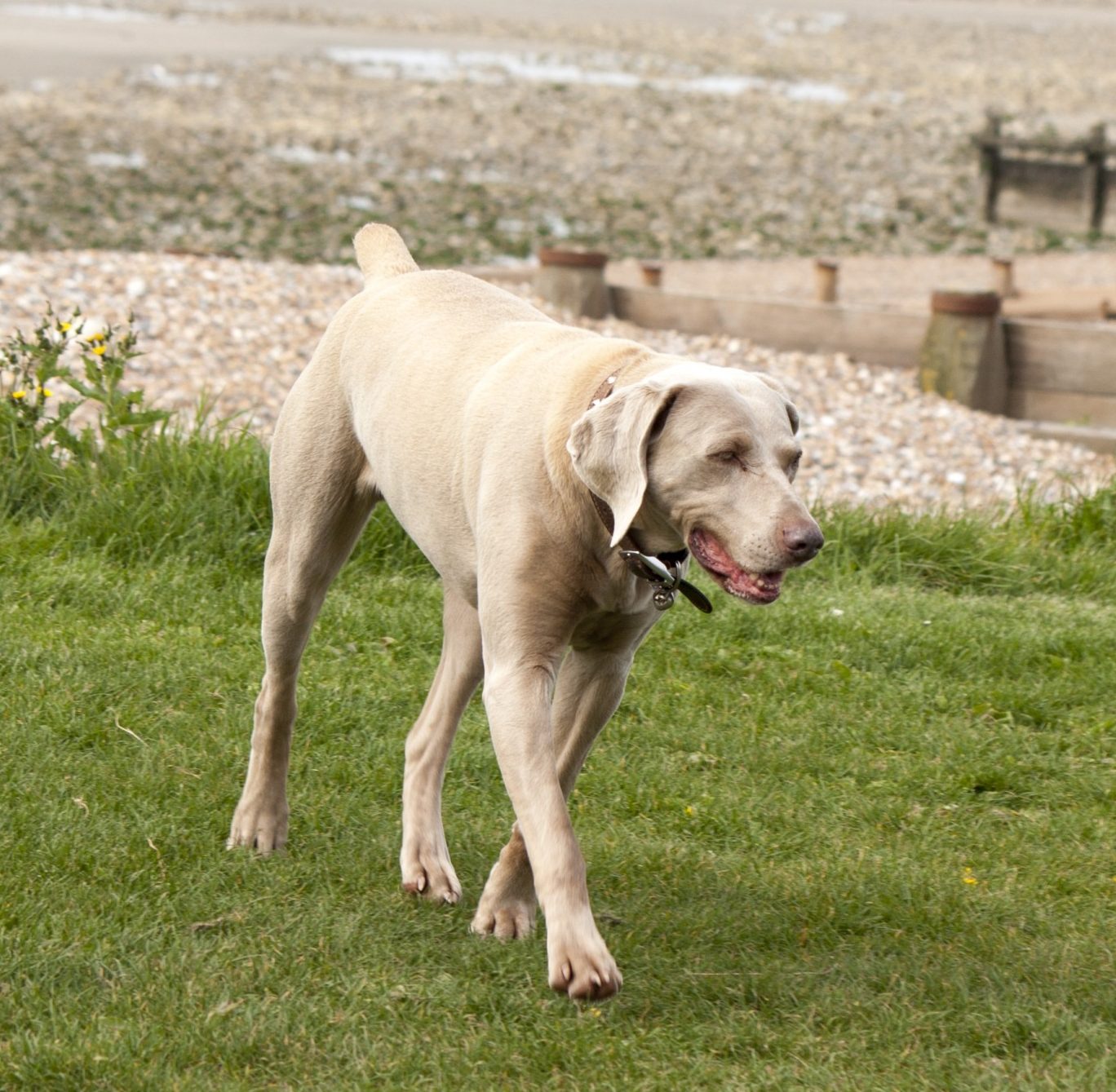Cataracts in dogs are common, just like they are in older people. Because dogs use their keen senses of smell and hearing to compensate, we often have trouble discovering that our dogs are losing their sight.
Weimaraners, just like other dog breeds, can lose their vision because of cataracts.
If you hunt with your Weimaraner you may think that you would know that your dog is not seeing the game as well as she used to. But because cataracts usually develop slowly, the changes in your Weimaraner dog’s vision will not be obvious to you, or to your dog.

The lens of your dog’s eye is the clear, soft, and transparent tissue that sits behind the iris (colored part) of the eye. When your dog has cataracts, the lens becomes cloudy and that makes his vision blurry and less bright.
As your Weimaraner ages, the chances of her getting cataracts increase. Because your dog won’t notice (and can’t tell you) that she can’t see as well, it’s up to you to observe her as she ages.
This article will discuss these topics:
- How do Cataracts Develop?
- Who gets Cataracts?
- Causes of Dog Cataracts
- Symptoms of Cataracts in Dogs
- Do Cloudy Eyes Always Mean Cataracts?
- Treatment for Canine Cataracts
How do Cataracts Develop?
When you look at the diagram of an eye above, the lens is a clear part of the eye in a healthy dog’s eye. As a dog ages, the lens sometimes becomes cloudy or opaque, and the cloudy lens blocks light from reaching the retina of the eye.

When the light is blocked from reaching the retina in your dog’s eye, he loses part of his eyesight or vision.
Depending on how cloudy the lens gets, your dog can have slight vision problems or he can become blind.
Cataracts usually start small and increase in size over time. Some grow fast and some are slower to grow.
When they are still little, canine cataracts do not really impair a dog’s vision. But the longer a dog has cataracts, the more mature they become.
And, as they mature, the lens becomes more and more cloudy. Eventually, with a mature cataract, all vision is lost. If nothing is done, the dog is blind.
Who Gets Canine Cataracts?
Most cataracts in dogs are inherited. And the dog breeds that are most likely to have inherited cataracts are listed below, with the age that they are usually first seen.
- Afghan Hound – 6 to12 months
- American Cocker Spaniel – 6 months or older
- Bichon Frise – older than 2 years
- Boston Terrier – present at birth or not seen until the dog is older
- Chesapeake Bay Retriever – older than 1 year
- German Shepherd – 8 weeks or older
- Golden Retriever – 6 months or older
- Labrador Retriever – 6 months or older
- Miniature Schnauzer – present at birth or seen when dog is 6 months or older
- Norwegian Buhund – 1 year or older
- Old English Sheepdog – present at birth
- Rottweiler – 10 months or older
- Siberian Husky – 6 months or older
- Staffordshire Bull Terrier – 6 months or older
- Standard Poodle – 1 year or older
- Welsh Springer Spaniel – present at birth
- West Highland White Terrier – present at birth
While Weimaraners are not among the breeds most likely to get canine cataracts, we do see cataracts in Weimaraner dogs occasionally.
Sometimes cataracts that were present at birth get smaller as the dog grows and the lenses get larger. In that case, the dog’s vision will get better as he matures and is no longer a puppy.
Causes of Dog Cataracts
Most cataracts are present when the dog is born. They can grow and become an issue at any age, but often we see cataracts growing and impairing vision as a dog becomes an older adult or a senior.
The second most common cause of cataracts is diabetes mellitus. If your dog has been diagnosed with diabetes, you should be especially vigilant. In dogs with diabetes, 75% develop cataracts within 9 months of being diagnosed with diabetes. And diabetic cataracts develop and mature fast – sometimes overnight!
Cataracts in dogs who are diabetic can be a medical emergency. But, if your dog is diagnosed with diabetes, you can actually prevent the formation of cataracts. If you give your dog Ocu-Glo supplement, a product developed by two ophthalmologists, you can help prevent diabetic cataracts from forming.
Other causes of cataracts in dogs include:
Other Diseases of the Eye
Sometimes dog cataracts develop when there is another eye problem that weakens the eyes. These include retinal degeneration or progressive retinal atrophy, uveitis (inflammation in the eye) and glaucoma.
Nuclear Sclerosis
As a dog ages, his pupils will develop a blue gray appearance. This is called nuclear sclerosis, and it is often confused with cataracts in dogs.
What happens is that the eye lens fibers get thicker and they start to dry out or lose their liquid. Some of the light that reaches the pupil is reflected back, and it gives your dog’s eyes the appearance of having cataracts.
When your vet examines your dog’s eyes closely, he will be able to tell if your dog has nuclear sclerosis (which does not affect a dog’s vision) or true dog cataracts.
Nuclear sclerosis does change the look of your pet’s eyes, but it does not affect his vision.
Trauma or Injury
If your dog’s eye was injured, it will be more likely to get cataracts. If your dog’s eye is injured, do seek medical attention from your vet.
Your dog’s eyes can also be injured by exposure to radiation. Dogs who have been treated for cancer with radiation, especially in the head area, are also more prone to getting canine cataracts.
Nutritional Deficiencies
If your dog is not getting everything she needs in her dog food, cataracts can develop. This can even happen with puppies, but they often get better as they grow.
Another condition that can cause cataracts is abnormally low calcium in your dog’s blood. This would have to be determined by blood tests.
Age-related Cataracts
Dogs over 8 years old often develop cataracts. They often stay small and do not cause blindness.
As we discussed above, cataracts in dogs often develops as a secondary condition for dogs with diabetes.
Symptoms of Cataracts in Dogs
Cataracts grow at different rates. Your Weimaraner dog may develop cataracts after she has reached the age of two. Because of their size, Weimaraners age more quickly than smaller breeds, and that means that they tend to get senior dog diseases and conditioners earlier than small dog breeds.
And if they have a cataract in one eye, Weimaraners usually also have a cataract in the other eye.
Often it is difficult to for owners to detect cataracts in their early stages. Here are some things to look for, if you suspect cataracts in your dog:
- Cloudy eyes
- Blinking or shying away from bright lights
- Difficulty seeing in dim lights
- Your dog seems uncertain when you are in unfamiliar places
- Your dog sticks very close to you, when she didn’t do this before
Do Cloudy Eyes Always Mean Cataracts?
Weimaraners who are older than 3 years old start to have a hardening of their eye lenses. This is similar to what happens with people who are over 40 years old. In people, near vision becomes blurry, and we all seem to need reading glasses at the same age.
When this happens with your dog, the lens will have a grayish cast. This is called nuclear sclerosis or lenticular sclerosis. It does not interfere with your dog’s vision, and light can still get through the lens to the retina. Because your dog never had great vision for close-up objects, she won’t notice any difference.
Just looking at your dog’s eyes, you won’t be able to tell the difference between nuclear sclerosis and cataracts, and a regular vet probably won’t either. But, if your vet suspects cataracts, she may refer you to a specialist, a veterinary ophthalmologist who specializes in diseases of animal eyes.
To make things even more complicated, your dog can have cataracts AND nuclear sclerosis at the same time.
How are Canine Cataracts Treated?
There are a few options for treating cataracts in dogs. I’ll look at each below and tell you the pros and cons of each approach.
Do Nothing
In years past, most people simply chose to do nothing. The only available treatment was surgery, and it was prohibitively expensive.
You can still choose to do nothing, and, in some cases, that might be the best choice. Many dogs get along just fine with dog cataracts and they retain a good deal of peripheral vision.
Once in a while, a dog will get “second sight”. This is when his vision returns after he has cataracts. Here’s what happens. The lens cracks and light can once again enter the eye.
If you decide to leave the cataracts alone, you will have to monitor your pet’s eyes carefully. Cataracts can cause inflammation and as they worsen, protein can leak from your dog’s eyes. On and off, for the rest of your dog’s life, you may have to treat his eyes for inflammation.
Surgery for Canine Cataracts
The second option, surgery, has been around for quite a while. Surgery is most successful when the condition is discovered early and the cataract is immature.
With people, cataracts are usually removed. When removed, the lenses are replaced by artificial lenses, and sight is restored.
With dogs, it’s not quite so simple. Not all dogs with cataracts need to have them surgically removed. In most cases, the cataracts are small and your dog still has fairly good vision.
When a dog has cataract surgery, it is to improve his vision and his quality of life. If your dog is old and has also lost her hearing or has dementia, having sight restored can be wonderful for your dog.
What to Expect with Surgery
In recent years, great strides have been made in cataracts for dogs. The Veterinary Teaching Hospital at the University of Illinois uses the very same kind of machine for dog surgery that is used for removal of human cataracts. It uses ultrasound waves to break up and remove the lens from the eye.
The lens is removed and then replaced with an artificial lens. Eye surgery is delicate surgery, and your dog will be under general anesthesia. If both eyes have cataracts, your dog will have surgery on both eyes at once.

Following surgery, your dog’s eye will be bandaged to prevent anything from coming into contact with it. Your dog may also have to wear an Elizabethan type collar to keep her from scratching or rubbing her eyes.
Surgery for cataract removal in dogs is expensive. It can easily cost $3000 per eye, and it probably will not be covered by insurance.
Many insurance companies consider cataracts in dogs to be normal for aging dogs, and they will have an exclusion in their policies.
Your Dog’s Sight after Surgery
Most dogs will see close to normal after surgery. However, dogs do have more inflammation in their eyes after surgery than people, and that can cause scarring. Scarring will mar your dog’s vision somewhat.
After surgery, you will have to put drops in your dog’s eyes, to cut down on scarring and prevent infection.
The good news is that, after your dog’s surgery, she will never have cataracts again.
Eye Drops – You can Opt to Skip the Surgery
Even if your dog is one of the few who become blind because of cataracts, she will probably adjust to being blind better than you would think. When you make simple adjustments to your home and work with your dog, she will be just fine, knowing that you are close and there to help.
There are two additional things that you can do to help your dog. Supplements and eye drops.
Here’s where treatment for dog cataracts gets really interesting. This is a non-invasive (not surgical) method, and doctors using it claim that it has been clinically tested for safety and effectiveness.
Over a period of weeks or months, you simply use N-Acetyl-Carnosine eye drops in your dog’s eyes. Within a few weeks, the clarity of the lens should improve. The eye will become less sensitive to light and your dog’s vision will improve.
The manufacturers claim that the N-Acetyl-Carnosine eye drops were found to be so safe for animals that they are now being used on people, with success.
Research on the drops was done in Russia and China over the last 15 years. The drops are now being used for dogs with cataracts, glaucoma and macular degeneration. Most pet owners use several drops in each eye every day, and the treatment will probably last for several months.
While they are not cheap, they are so much less expensive than cataract surgery, that they are certainly worth a try!
Bright Eyes Carnosine Eye Drops
Bright Eyes Drops (seen on UK National TV on the Richard and Judy TV Show) can also be used with your dog, if you are not going to pursue surgery. This product has also been tested, with good results.
Bright Eyes drops are eye drops that you put in your dog’s eyes. They are used for dogs with cataracts, glaucoma, macular degeneration and for dogs who are diabetic.
Nothing used for dog cataracts is cheap, and that is also true for these eye drops.
If you suspect that your dog has cataracts, the first thing to do is have her checked by your vet. Your vet may then refer you to a dog eye specialist.
If your dog does have a diagnosis of cataracts, you will need to decide how much you can afford to spend, and which approach seems reasonable, based on your dog’s age and general health.
Ocu-GLO Supplement to Prevent Cataracts in Dogs
Ocu-GLO is a supplement developed by two ophthalmologists, and it is best used routinely with a dog who is prone to getting cataracts. They serve as a preventative measure for dogs that don’t yet have a problem and they can also help prevent canine retina issues after cataract surgery.
This supplement is the only food supplement made for dogs’ eyes that has research and clinical studies to back it. If you decide not to have surgery for your dog or you want to prevent further eye problems, this supplement is certainly worth looking into.
In some studies, when this product was used, cataracts were almost reversed, something unheard of!
Not cheap, it’s certainly a lot more affordable than cataract surgery!
Dog eye problems can develop gradually or very quickly. If you know the symptoms to look for, it will help your veterinarian immensely when he diagnoses your dog’s eye problem.
Most importantly, if you catch conditions like canine cataracts early, you have a much better chance of having your pet recover fully!






Leave a Reply